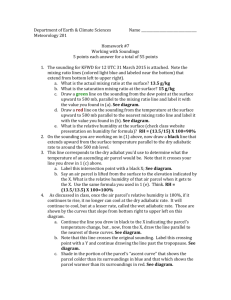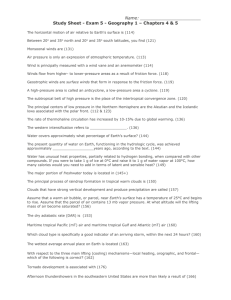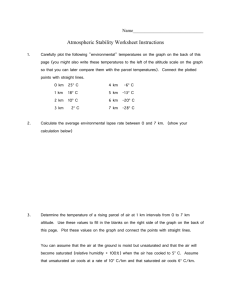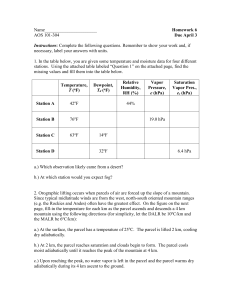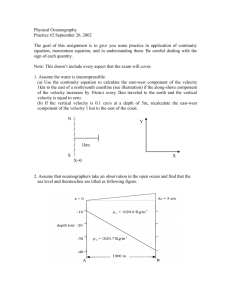Word - Atmospheric Sciences
advertisement
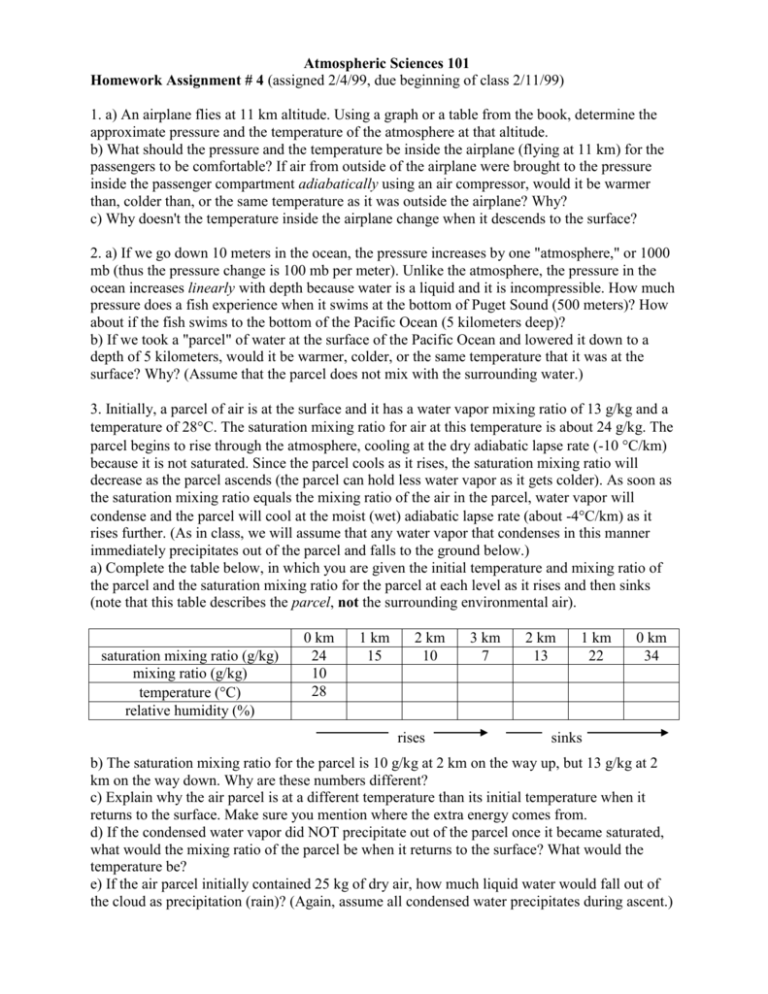
Atmospheric Sciences 101 Homework Assignment # 4 (assigned 2/4/99, due beginning of class 2/11/99) 1. a) An airplane flies at 11 km altitude. Using a graph or a table from the book, determine the approximate pressure and the temperature of the atmosphere at that altitude. b) What should the pressure and the temperature be inside the airplane (flying at 11 km) for the passengers to be comfortable? If air from outside of the airplane were brought to the pressure inside the passenger compartment adiabatically using an air compressor, would it be warmer than, colder than, or the same temperature as it was outside the airplane? Why? c) Why doesn't the temperature inside the airplane change when it descends to the surface? 2. a) If we go down 10 meters in the ocean, the pressure increases by one "atmosphere," or 1000 mb (thus the pressure change is 100 mb per meter). Unlike the atmosphere, the pressure in the ocean increases linearly with depth because water is a liquid and it is incompressible. How much pressure does a fish experience when it swims at the bottom of Puget Sound (500 meters)? How about if the fish swims to the bottom of the Pacific Ocean (5 kilometers deep)? b) If we took a "parcel" of water at the surface of the Pacific Ocean and lowered it down to a depth of 5 kilometers, would it be warmer, colder, or the same temperature that it was at the surface? Why? (Assume that the parcel does not mix with the surrounding water.) 3. Initially, a parcel of air is at the surface and it has a water vapor mixing ratio of 13 g/kg and a temperature of 28C. The saturation mixing ratio for air at this temperature is about 24 g/kg. The parcel begins to rise through the atmosphere, cooling at the dry adiabatic lapse rate (-10 C/km) because it is not saturated. Since the parcel cools as it rises, the saturation mixing ratio will decrease as the parcel ascends (the parcel can hold less water vapor as it gets colder). As soon as the saturation mixing ratio equals the mixing ratio of the air in the parcel, water vapor will condense and the parcel will cool at the moist (wet) adiabatic lapse rate (about -4C/km) as it rises further. (As in class, we will assume that any water vapor that condenses in this manner immediately precipitates out of the parcel and falls to the ground below.) a) Complete the table below, in which you are given the initial temperature and mixing ratio of the parcel and the saturation mixing ratio for the parcel at each level as it rises and then sinks (note that this table describes the parcel, not the surrounding environmental air). saturation mixing ratio (g/kg) mixing ratio (g/kg) temperature (C) relative humidity (%) 0 km 24 10 28 1 km 15 2 km 10 rises 3 km 7 2 km 13 1 km 22 0 km 34 sinks b) The saturation mixing ratio for the parcel is 10 g/kg at 2 km on the way up, but 13 g/kg at 2 km on the way down. Why are these numbers different? c) Explain why the air parcel is at a different temperature than its initial temperature when it returns to the surface. Make sure you mention where the extra energy comes from. d) If the condensed water vapor did NOT precipitate out of the parcel once it became saturated, what would the mixing ratio of the parcel be when it returns to the surface? What would the temperature be? e) If the air parcel initially contained 25 kg of dry air, how much liquid water would fall out of the cloud as precipitation (rain)? (Again, assume all condensed water precipitates during ascent.) 4. a) In Seattle in the middle of Winter, a 1 kg parcel of air has a saturation mixing ratio of 12 grams of water vapor per kilogram of dry air. The relative humidity is 90% (it is moist and overcast). Calculate the mixing ratio of the air parcel. b) In Death Valley at the same time of the year, because the temperature is higher, a 1 kg air parcel has a saturation mixing ratio of 38 g/kg. The relative humidity is 40% (dry). Calculate the mixing ratio of the air parcel. c) Which parcel contains the most water vapor molecules per kilogram of dry air? Was this obvious if we had only considered the relative humidity? Do you think that we "feel" relative humidity or mixing ratio? Height (m) Height (m) 1000 1000 4:00 p.m. 800 Environmental lapse rate 800 600 600 400 400 200 200 0 10 20 Temperature (C) 30 4:00 a.m. 4 p.m. environmental lapse rate 0 10 20 Temperature (C) 30 5) The two graphs above show the vertical temperature structure (sometimes called the "environmental lapse rate") of the first 1000 meters of the atmosphere during a warm summer afternoon (4:00 p.m.) and on the following calm, clear summer night (4:00 a.m.). The 4 p.m. lapse rate it dashed in the 4 a.m. graph for reference. Note that above 200 m, the air temperature has only decreased 5C during the night, but the surface air temperature has dropped 20C, so that a temperature inversion layer is present in the bottom 200 m of the atmosphere at 4 a.m. a) Why does the air near the surface cool more than the air above 200 m during the night? (Hint: recall that air is an excellent insulator--it doesn't conduct heat very well.) b) Consider a parcel of air at the surface (altitude 0 m, temperature 30C), at 4:00 p.m. If this air parcel were lifted dry adiabatically to 500 m, what would be the temperature of the parcel? d) What would be the temperature of the environmental air surrounding the parcel at 500 m? e) Recall that cold air is denser than warm air. Comparing the temperature of the parcel to the environmental temperature, do you think the parcel will now rise, remain at 500 m, or sink? f) Repeat questions (b-c-d-e) for a parcel of air pushed up from the surface (10C) at 4:00 a.m. g) Which situation would you describe as "stable", and which one as "unstable"? 6. If it is 30C and the water vapor pressure is 20 mb, what is the dewpoint temperature? What is the relative humidity of the air? For this problem, use Figure 4.4 (which should be a plot of saturation vapor pressure versus temperature) from the book.



